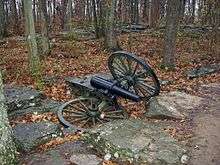Stones River National Battlefield
| Stones River National Battlefield | |
|---|---|
|
IUCN category V (protected landscape/seascape) | |
  | |
| Location | Rutherford County, Tennessee, USA |
| Coordinates | 35°52′34″N 86°25′51″W / 35.87611°N 86.43083°WCoordinates: 35°52′34″N 86°25′51″W / 35.87611°N 86.43083°W |
| Area | 728.41 acres (2.95 km2) |
| Established | March 3, 1927 |
| Visitors | 206,425 (in 2005) |
| Governing body | National Park Service |
| Website | Stones River National Battlefield |
Stones River National Battlefield, a 570-acre (2.3 km2) park along the Stones River in Rutherford County, Tennessee, three miles (5 km) northwest of Murfreesboro and twenty-eight miles southeast of Nashville, memorializes the Battle of Stones River, a key battle of the American Civil War that took place on December 31, 1862 and January 2, 1863, which resulted in a strategic Union victory.[1]
Creation of the National Battlefield
The national battlefield was established through the efforts of both private individuals, the Stones River Battlefield and Park Association, the Nashville, Chattanooga and St. Louis Railway (in 2011, part of CSX Transportation), and by a 1927 act of Congress authorizing a national military park under the jurisdiction of the War Department.[2]
During the early years of the twentieth century, the railroad used the battlefield to increase passenger traffic. It promoted veteran reunions and acquired parts of the battlefield as points of historical interest. In 1906, the company erected a 31-foot (9.4 m) obelisk to commemorate the January 2, 1863, position of massed Union artillery used to repel a Confederate assault on Union troops across the river.[3]

The Stones River Battlefield and Park Association was chartered on April 28, 1896, after the establishment of Chickamauga and Chattanooga National Military Park increased interest in preserving significant Civil War battlefields. The association secured options on property connected with the battle, reportedly 3,400 acres (14 km2) by June 1897. Association members erected wooden signs to mark and interpret battlefield locations.[4] In 1912, the Association lobbied to have Congress “establish an accurate system of markers," but the measure failed, in part because of the testimony of former congressman and Chickamauga and Chattanooga National Park Commissioner Charles H. Grosvenor, who believed the landmarks had been "entirely obliterated."[5]
Land acquisition began in 1928 and was completed in 1934. In 1992, the park accepted a donation from the City of Murfreesboro of an intact segment of Fortress Rosecrans, the largest enclosed earthwork built during the Civil War. The park preserves less than a fifth of the more than three thousand acres (12 km2) over which the battle was fought.[2]
The site was established as Stones River National Military Park on March 3, 1927. It was transferred from the War Department to the U.S. Department of the Interior's National Park Service on August 10, 1933, and redesignated a national battlefield on April 22, 1960. As with all historic areas administered by the National Park Service, the battlefield was listed on the National Register of Historic Places (October 15, 1966).
On April 10, 2009, the Good Friday tornado damaged the battlefield park.[6]
Cemetery

Within park boundaries is Stones River National Cemetery,[7] 20.09 acres (81,300 m2) with 6,850 interments (2562 unidentified). Just outside the cemetery proper is the Hazen's Brigade Monument (1863),[8] the oldest surviving American Civil War monument standing in its original location. The 32nd Indiana Monument at Cave Hill National Cemetery in Louisville, Kentucky is a year older. An even earlier monument was erected after the First Battle of Manassas in Virginia but is no longer extant.[9] Also, veterans from Army of the Cumberland erected the U.S. Regular Brigade Civil War Monument.[10]

The cemetery was established on March 29, 1864 by the order of Major General George H. Thomas. Under the supervision of Chaplain William Earnshaw, the 111th Regiment United States Colored Troops disinterred bodies from the battlefields of Stones River, Murfreesboro, Franklin, Shelbyville, Tullahoma and Cowan.[11] Reburials began in 1865 and were completed by 1867. The cemetery was transferred from the War Department to the National Park Service on August 10, 1933. Most of the Confederate dead were taken to their towns or to the nearest southern community. Some, however, were buried in a mass grave south of town and later reinterred in another mass grave, Confederate Circle in Evergreen Cemetery in Murfreesboro.
In November 1867, 1,360 bodies were removed from Rose Hill Cemetery in Columbia, Tennessee, where a national cemetery had earlier been planned.
References
- ↑ Sean M. Styles, Stones River National Battlefield Historic Resource Study (National Park Service, 2004),1.
- 1 2 Styles, 1.
- ↑ Styles, 64–65.
- ↑ Styles, 65; Jesse W. Sparks, “Stones River Battlefield and Park Association,” Confederate Veteran, 5, No.1 (1897): 31; Sparks, “The Stone’s River Battle-Field,” Confederate Veteran, 6, No. 2 (1898): 58.
- ↑ Styles, 66.
- ↑ Several trees were toppled and the park closed for three weeks: Historynet's Tornado Strikes Stones River National Battlefield Park
- ↑ U.S. Geological Survey Geographic Names Information System: Stones River National Cemetery at 35°52′53″N 86°25′56″W / 35.88139°N 86.43222°W
- ↑ Hazen's Brigade Civil War Monument at Find a Grave
- ↑ German Indiana Regt. Monument To be Preserved
- ↑ U.S. Regular Brigade Civil War Monument at Find a Grave
- ↑ Stones River National Cemetery – History
External links
| Wikimedia Commons has media related to Stones River National Battlefield. |
- Stones River National Battlefield
- The Battle of Stones River: The Soldiers' Story, a National Park Service Teaching with Historic Places (TwHP) lesson plan
- Stones River National Cemetery
- McGavock Confederate Cemetery
- Civil War Trails
- Tornado Strikes Stones River National Battlefield Park – A photo article illustrating damage to the park from the 2009 tornado.
- U.S. Geological Survey Geographic Names Information System: Stones River National Battlefield (Park)
- U.S. Geological Survey Geographic Names Information System: Stones River National Battlefield (Locale)
- Stones River National Cemetery at Find a Grave